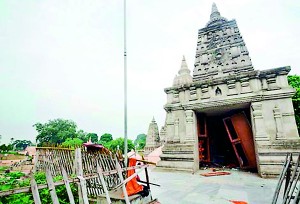Sunday Times 2
Who let bombs out in Buddha Gaya?
View(s):Home minister Sushil Kumar Shinde’s observation that anybody – from the Indian Mujahideen to local terror groups – could have been responsible for the Bodh Gaya blasts sums up the state of confusion even six days after the incident. What the NSG-NIA and the Bihar

The entrance to a Budhist temple edifice at the Bodh Gaya Buddhist temple complex appears torn apart after 9 low-intensity blasts took place (AFP)
Police teams, working on the 18 material and forensic evidence collected from the site, have to say is they need more time to decide whether the bombs were devised by the IM – which warned of another attack on Mumbai very soon in a twitter message – or some local group.
The local angle got prominence as tags, written in Urdu, were found on unexploded bombs, indicating the spots they were meant for – quite unprofessional by the standards of the IM.
What further confused the investigators is the tag on a bomb planted in a stationary bus, saying “In protest for Iraq.”
Broadly three points that are adding to the confusion are: The motive, the reasons why no organisation has come forward to claim responsibility and the bizarre timing of the bombs.
The 13 bombs were timed to go off simultaneously at 5.30am – as if to avoid large-scale loss of life – although they exploded at various times.
The NSG forensic team found four unexploded bombs – small gas cylinders containing ammonium nitrate and sulphur with ball bearings and nails. They were so crude that the impact of the first blast altered the mechanism of the others and reduced their yield potential.
But the real issue is how explosive-filled cylinders, weighing 2.5 kg each, could have been planted at night without the help of insiders. That’s why chief minister Nitish Kumar indirectly blamed the temple authorities for failing to ensure security at night.
Also, Bihar Police chief Abhayanand said none of the explosives were planted in the line of sight of the CCTV cameras and the fact that each could have required four men to plant them strengthens the insider support theory.
 So, the investigators are focusing on the neo-Buddhist groups fighting for the control of the temple, although they are also looking at anti-Buddhist Rohingya militants from Myanmar and new terror groups in Bangladesh.
So, the investigators are focusing on the neo-Buddhist groups fighting for the control of the temple, although they are also looking at anti-Buddhist Rohingya militants from Myanmar and new terror groups in Bangladesh.
The answer to the confusion and vulnerability, experts say, lies in the way India’s counter-terrorism agencies function. Even five years after the 26/11 Mumbai attacks, the counter-terror operation is mired in politics, turf war and archaic policing.
Just before the blasts, the lead agency for fighting terror, the Intelligence Bureau, got into a spat with the CBI over the alleged involvement of its special director Rajinder Kumar in the Ishrat Jahan fake encounter case.
Intelligence officials say Rajinder Kumar’s case shows that the IB has to bring transparency in its counter-terror strategy. And the Bodh Gaya attack has provided a breather to the IB as it strengthened the fear of the terrorist.
What’s more, the Bodh Gaya blast is the second instance of police inaction after the Hyderabad blasts in February this year. In both cases, state police forces were alerted well in advance, but no action was taken.
(Courtesy Hindustan Times)
Follow @timesonlinelk
comments powered by Disqus

